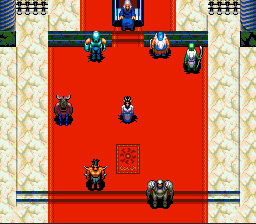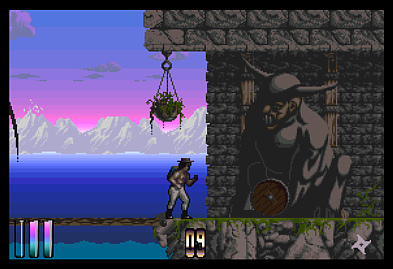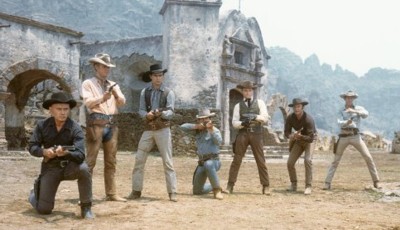
The 7th Saga (1993 - SNES) 
The 7th Saga has the most overrated difficulty of any game I've played since Contra. That's not to say it's Final Fantasy Mystic Quest-easy, but either I chose the most kick-ass team possible (I had Esuna and Kamil) or I'm one of the few who figured out that you need to do a little more than just choose "Fight" on the menu to get very far without endless level-grinding. Those who attempt the latter tend to be frustrated by the Level 80 experience cap, but I beat it at 60 - twenty levels below the cap - and the final boss wasn't even that hard. I got him on my first try.
The 7th Saga doesn't have much to offer in the way of story, and it seems to have been specifically written for Lux, the robot, as one of the few major plot points is learning about the place where he came from, and he's the only character who could theoretically be happy with (or at least indifferent to) the ending, which is (unfortunately) the same for all characters (though, in a good example of "Be careful what you wish for", it's tragically ironic for Olvan).
But what The 7th Saga does have going for it is a decent (though not impossible) challenge that often forces you to rely on mixed strategies of using magic and physical attacks, healing, defending, and using spells and items that boost your stats. Who you choose to play as (out of seven "apprentices", though you can recruit one more later) may also affect your strategy. The beginning of the game follows a very linear path, but when you reach the northern continent, it suddenly becomes completely non-linear.
Near the end, the game starts throwing things at you that totally change the rules, such as (temporarily) losing the ability to use magic. These events frustrate some players, but quite frankly, my party was pretty much invincible, and a wrench really needed to be thrown into the works because the game was running low on ideas. There are many palette-swapped enemies, and even amongst the completely new ones, they're still using the same Petrify, Ice, and Fire spells they were using earlier, and oh yeah, instant death spells, too, although there are ways to protect against those.
With that said, I will agree that the one abnormally difficult part of the game are two non-optional apprentice fights. I never had any trouble with the first one, but the second one against the Sky Rune thief stumped me years ago when I first attempted to beat this game. However, there are tricks that can help with these fights, though you might have to look them up on the internet.
Though I doubt most people, even if they like The 7th Saga, are going to want to replay it with every single character, it's nice that the option is there to choose someone else and have a slightly different experience if you ever do want to replay it. It also has some good music, and the Mode 7 battle graphics, in which your characters and the enemies and spells are all fully animated and viewed in 3rd-person perspective, are exceedingly well-rendered.
Rating: 4/5

Shadow of the Beast III (1992 - Amiga)
My first foray into the world of Amiga gaming wasn't exactly smooth. I had a real devil of a time trying to get this game to run. First, the WinUAE emulator would chug and stutter, until I figured out I couldn't run it with Firefox maximized. Then it kept automatically assigning the Fire button to the right and left on my D-pad, so when I tried to make the character run, he'd stop and shoot his weapon first. I switched controllers to solve that problem. Then, just when I had it all figured out, the Fort Dourmoor level wouldn't load and the emulator crashed.
Several internet fixes, and an uninstall and reinstall later, the emulator was finally running at the correct speed, the last level finally loaded, and I beat it just hours later. The experience enlightened me to some probable reasons why the Amiga is not the most popular of gaming systems. The loading delays and constant disk-switching require an ample amount of patience (at least using save states helps get around some of it).
Shadow of the Beast III has the unfortunate circumstance of only ever having been released on this system. As a puzzle-platformer in the vein of Out of This World, though with slightly more emphasis on action, it's not that it's bad. It's just a little short and probably not notable enough for the average person to figure out the Amiga emulation to play it. Those who are already into Amiga emulation, or the hopelessly curious, may want to give it a shot as it's an inoffensive way to spend a few hours, the surreal graphics and desolate atmosphere are nice, and the puzzles (which make the most liberal use of wooden tables I've ever seen) can be daunting to solve.
Some aspects of Beast III could've used a little fine-tuning, particularly the fish tank puzzle controls and the ease of accidentally pushing an object a pixel too far, which can force you to restart the whole stage. It wouldn't be so bad if not for the loading delays you'll have to sit through if you mess up enough to get a Game Over, so I'm not ashamed to say I used save states to create reasonable checkpoints.
(To be followed up with a complete review in which I talk more about the actual game and less about the Amiga itself.)
Rating: 3/5




Dodgeball: A True Underdog Story (2004 - DVD) 
I'm not sure why it is sometimes that I enjoy stupid comedy movies like this one, especially considering I've seen this plot a million times - characters need to earn a huge sum of cash quickly and must do something extraordinary and typically beyond their normal abilities to get it. This is the basic plot of The Blues Brothers, The Goonies, The Three Stooges NES game, and various other movies and TV show episodes. In this case, the members of Average Joe's Gym (led by Vince Vaughn) must win a Dodgeball tournament, despite that none of them have ever played Dodgeball before, or risk losing their gym to the competing Globo Gym, who also enter a team in the tournament (led by Ben Stiller), in an attempt to keep the Average Joes from winning.
In retrospect, some of the humor, particularly that involving Ben Stiller's over-the-top characterization of Globo Gym owner White Goodman, is too homophobic for my tastes (though there is one positive representation of a bisexual character to balance it out), and there is a lot of double-entendres involving balls, as one might very well expect. Still, the characters are likable, and when the humor works, it's dead-on. This movie has the single best use of Chris de Burgh's "Lady in Red" I've ever seen. And despite the Average Joes being a very unconventional team, especially with having a member who talks and dresses like a pirate (!!!), some of the teams they face in the tournament manage to be even more outrageous - like the "Skillz That Killz" who...oh, never mind. It'll be a lot funnier if you see it for yourself.
Rating: 3.5/5

The Magnificent Seven (1960 - DVD) 
The Magnificent Seven is Akira Kurosawa's The Seven Samurai remade as a western. Seven gunslingers, some played by popular actors such as Yul Brynner, Steve McQueen, Charles Bronson, Robert Vaughn, and James Coburn (though a few weren't well-known at the time), are hired to protect a small farming town in Mexico that's being antagonized by a group of bandits who regularly raid the town for its food. The beginning of the movie does a great job at painting each character's portrait, giving them memorable introductions that express their individual motivations and strengths of character, especially considering there's seven of them to keep track of here. One gunman, the gold-hunting Harry, is only it for the money. Another, the rookie Chico, is out to prove something. Some are too broke to have much choice of refusal, and others, well... As McQueen's Vin puts it, "it seemed like a good idea at the time".
The dialogue is sharp and witty, and the screenplay places as much emphasis on good old-fashioned storytelling as it does the expected gunfights and action of a classic western. If you think the whole of the movie is too light on the latter, just wait until you get the final scene. There is also a measure of philosophical ruminating on the lives of traveling guns for hire in the old west - Though the movie calls them the "magnificent" seven, these characters are not quite portrayed as the infallible heroes of a typical western. They have very human flaws, some of which will eventually come back to bite them. As the movie closes, the feeling is that not only has this story met its end, but the entire Era of the Wild West Hero is gradually fading away.
Interesting to note, too, is that even the villain's leader, Calvera (played by Eli Wallach) is given reasonable motivation for his actions. But he is also given other options and refuses them, so there is a distinct labeling of "good guys" and "bad guys", yet it's enough that the conflict doesn't feel one-dimensional.
Rating: 4.5/5




Saturday Night Live: The Best of Dan Aykroyd (1975 - DVD)
Yet another Saturday Night Live compilation that tends to be a rollercoaster of good and mediocre. I guess one good thing about this particular collection is that I don't think any sketch on here was downright bad, as some sketches on previous collections I've reviewed were. For some sketches, I either only remembered parts of them, or I only ever saw certain parts of them. But the weird thing is that the parts I remembered...tend to be the only parts that are funny. Take, for example, the Lisa Loopner sketch where Gilda Radner and Bill Murray are laughing at a refrigerator repairman (played by Aykroyd) whose pants are falling down. That's the only part of that sketch I remembered, and that's the only part of it that's funny. (I earlier lamented that this sketch wasn't on the Gilda Radner DVD. I redact that statement now because I didn't realize it was on this one.) I also remembered Fred Garvin, the male prostitute, striking ridiculous "sexy" poses on a bed - again, rest of the sketch...not that funny.
A few winners include Aykroyd's sleazy salesman, Irwin Mainway and his alarmingly dangerous Halloween costumes (though I'm disappointed the DVD didn't contain the sketch with his equally-dangerous toys), the Julia Child parody (not for the squeamish), one Blues Brothers performance, and E. Buzz Miller... who passes himself off as an "art critic", but really just likes to point and laugh at nudity in creepy old paintings.
I have to confess I'm not the world's biggest fan of the Czech Brothers or the Coneheads, though I suppose I did get a laugh out of the way Aykroyd was blowing the Tang powder out of his nose completely stonefaced in the latter.
Rating: 3/5







